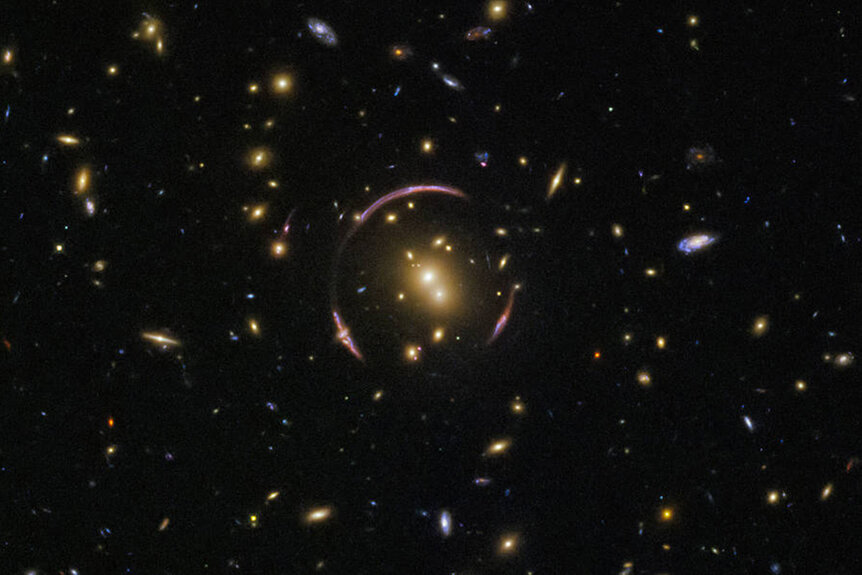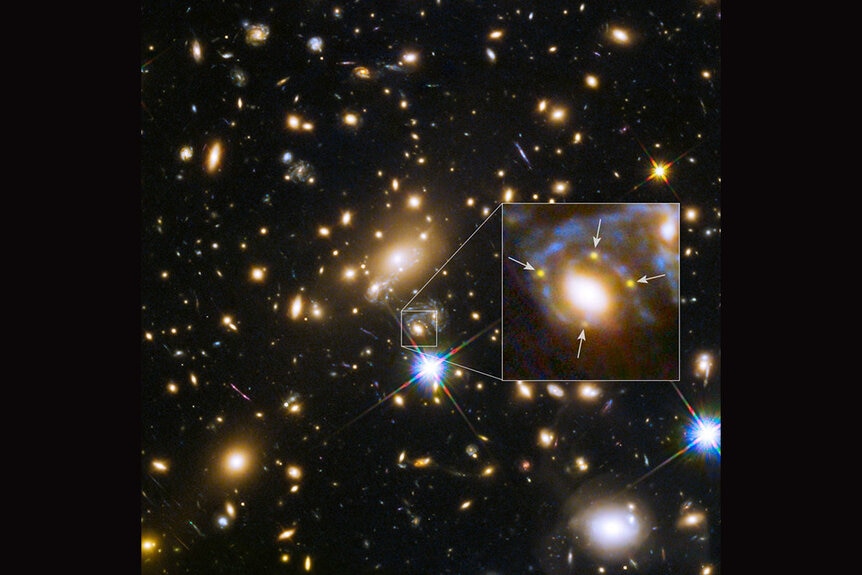Create a free profile to get unlimited access to exclusive videos, sweepstakes, and more!
Gravitational Einstein Cross Reveals Four Copies of Distant Supernova
It's like the universe saying, "Hey, look at this!"
Even if the Ark One hadn’t taken damage in deep space, woken everyone up from their stasis pods, and threatened the lives of the remaining crew members on SYFY's The Ark (streaming now on Peacock!), we’re not sure it’s a trip we’d sign up to take. Stepping foot on a planet orbiting another star would be an incredible opportunity, but there’s not a lot of scenery along the way.
Space is big, and it’s mostly empty, but if you know where to look you can catch a glimpse of things that will bend your mind like you’re falling into a black hole. Recently, an international team of researchers discovered a distant supernova with a little help from the universe itself. Their findings were published in the journal Nature Astronomy.
Gravitational Lensing Reveals Distant Objects in Space
Light travels to us in more or less a straight line from its point of origin to our eyes or astronomical instruments. When light racing through space encounters a massive object, however, like a black hole or a galaxy cluster, gravitational distortions in space-time will bend the light much like light bending through a lens. As a result, astronomers call these interactions gravitational lenses.
RELATED: Hubble Captured a Supernova at Three Different Ages in One Image
As a result, we can sometimes see objects which would otherwise be hidden from us, either because they are outside of our line of sight or because they are too far away. Gravitational lenses act like great natural telescopes distributed throughout the cosmos, and we can take advantage of them when they line up between us and an object we want to see.
In the new study, astronomers were observing at the Zwicky Transient Facility (ZTF) in California, which scans the night sky searching for new light sources. It has an incredibly wide field of view, but is limited in distance and resolution. On August 4, 2022, astronomers at ZTF detected a supernova from a much farther distance than should have been possible with their instruments, suggesting a previously unknown gravitational lens.
When light bends around a gravitational lens, it often does so in multiple directions. Light coming toward the lens will take various paths, like drops of water down Dr. Sattler’s hand, and arrive in different places. As a result, you can get some weird images by the time the light hits our telescopes. Sometimes lensed objects are smeared out in a circle around the lens, in a phenomenon known as an Einstein Ring. Other times, the light can take distinct paths and result in copies of the same object arriving all at the same time in what’s known as an Einstein Cross. In those instances, four complete copies of an object will appear at compass points around the lens.
The Supernova SN Zwicky
The newly discovered supernova, dubbed Supernova (SN) Zwicky, is notable not only for its distance but also for its type. It’s what’s known as a type Ia supernova, which occur when a white dwarf star cannibalizes material from a binary companion, usually a red giant. As it sucks material away from its partner, the white dwarf becomes increasingly massive, which will eventually cause a catastrophic problem.
Ordinary stars remain stable by balancing the inward force of gravity and the outward thermal pressure of fusion. White dwarf stars have to fight off gravity, but they don’t have any thermal pressure to do it with. Instead, they rely on electron degeneracy pressure — basically, no two electrons can occupy the same space — which prevents the white dwarf from collapsing further. When it reaches what’s known as the Chandrasekhar limit of roughly 1.44 solar masses, the gravitational pressure overwhelms the electron degeneracy pressure inside and the star implodes in a supernova. When that happens, they temporarily become some of the brightest objects in the universe.
RELATED: A Warning System for When Stars go Supernova
Because type Ia supernovae are generated by repeatable processes and are therefore a consistent brightness, astronomers use them as “standard candles” to measure distances in space. If you know the true brightness of something, you can look at its apparent brightness and work out how far away it is. You can then use that information to crunch the numbers on other objects in associated space.
That’s why SN Zwicky turned heads when it was uncovered. While the ZTF is typically limited to about 1.3 billion light-years, SN Zwicky hails from 4 billion light-years away, roughly three times their supposed limit. As a result, astronomers at ZTF knew right away they were looking at a lensing event, even though they couldn’t resolve the separate images. That’s because the gravitational lens magnifies the light from SN Zwicky roughly 25 times.
"Strongly lensed Type Ia supernovae allow us to see further back in time because they are magnified. Observing more of them will give us an unprecedented chance to explore the nature of dark energy," said Joel Johansson, a postdoctoral fellow at Stockholm University and a co-author on the study, in a statement.
After discovery, additional observations were made at the Very Large Telescope in Chile, the Keck Observatory in Hawaii, and the Hubble Space Telescope. The Keck telescope’s incredible resolution was able to confirm the hypothesis and resolve four distinct images of SN Zwicky.
What’s more, despite traveling 4 billion light-years along different gravitationally dictated paths, the four images arrived at Earth almost simultaneously. The difference in arrival time between each of the four images is less than a day. Future observations of SN Zwicky are planned, using NASA’s James Webb Space Telescope (JWST), and could give us an even clearer view of one of the weirdest things we’ve ever seen in the night sky.
Catch the complete first season of The Ark, streaming now on Peacock!




































